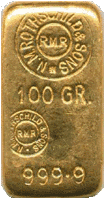 Rothschild,
The Bank Built On Gold, Quits Market Rothschild,
The Bank Built On Gold, Quits Market
By William Kay
15 April 2004
The Independent.uk
After 261 years, N.M. Rothschild
& Sons, the most prestigious bank in the City of London still
owned by its founding family, shocked the financial world yesterday
when it pulled out of trading in gold and other commodities.
The chairman, David de Rothschild, said: "Our income from
commodities trading in London, including gold, has fallen as
a percentage of our total income in each of the past five years.
Following a strategic review of our activities we have concluded
that this is no longer a core area of activity and have, therefore,
decided to withdraw from the market. "We remain committed
to growing further our activities in specialist commercial banking,
private banking and trust services, and objective relationship-based
investment banking advice."
As part of the decision, Rothschild will no
longer take part in the twice-daily London Gold Fixing, which it currently chairs and which
has been held in its offices since 1919. Rothschild's roots lie
in gold. Its origins date back to 1743 when a German goldsmith,
Amshall Moses Bower, opened a counting house in Frankfurt. He
placed a Roman eagle on a red shield over the door. Rothschild
is German for "red shield,"
and Bower's son adopted the name. By the end of the 18th century
Rothschild was lending to governments and helped to finance the
Napoleonic wars in the early 19th century. Nathan Rothschild
paid for an attack on France by the Duke of Wellington by smuggling
gold through France. Through its command of gold Rothschild effectively
became paymaster to the British Army.
In 1825 Rothschild rescued
the Bank of England after a run on gold, causing an economic
crisis and the collapse of 145 banks. Rothschild shipped £10m
of gold into the Bank and became its official gold broker. Rothschild
manufactured gold bars for more than 100 years, until 1967. It
also owned and operated the Royal Mint. By the end of the 19th
century Rothschild had twice bailed out the US government when
its gold reserves fell to what were regarded as dangerously low
levels.
After the First World War,
the victorious governments were anxious to stabilise the price
of gold, and asked Rothschild to organise what became the London
Gold Fixing. Despite the development of 24-hour trading, at 10.30am
and 3pm, every day for the past 85 years, representatives of
the five leading London gold dealers have met at Rothschild's
offices in St Swithin's Lane to fix the price.
321gold Inc

|